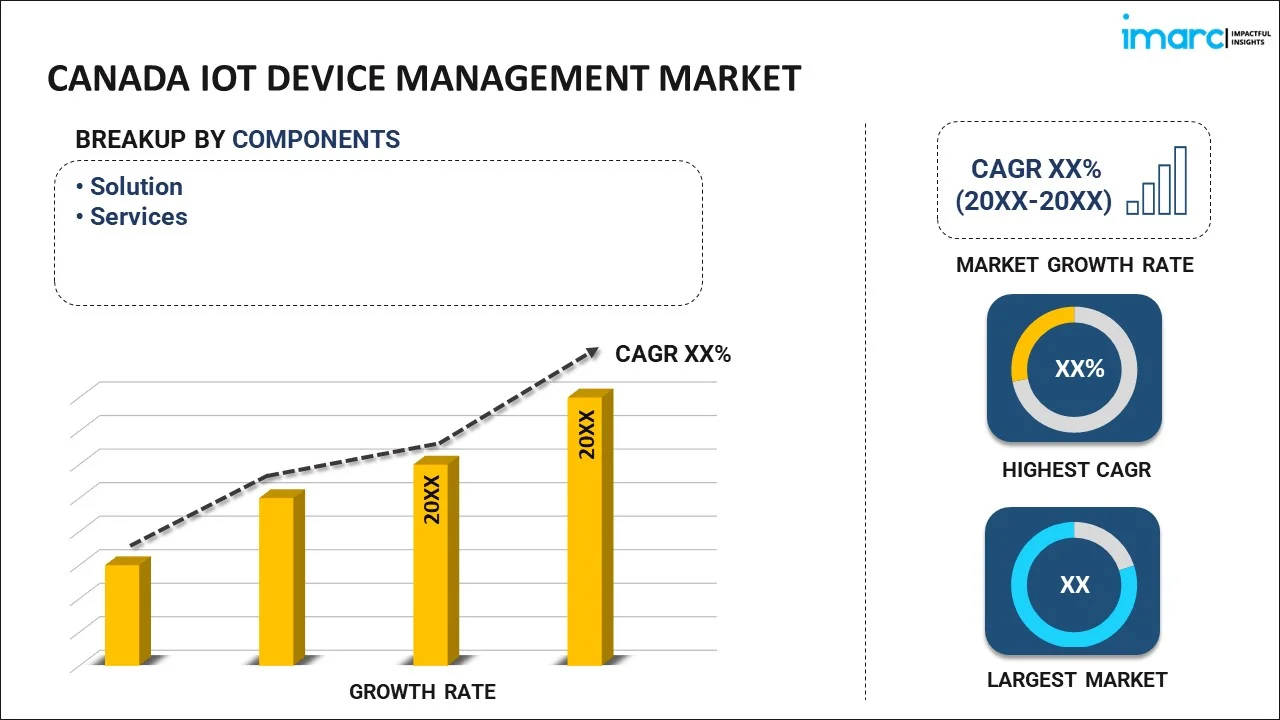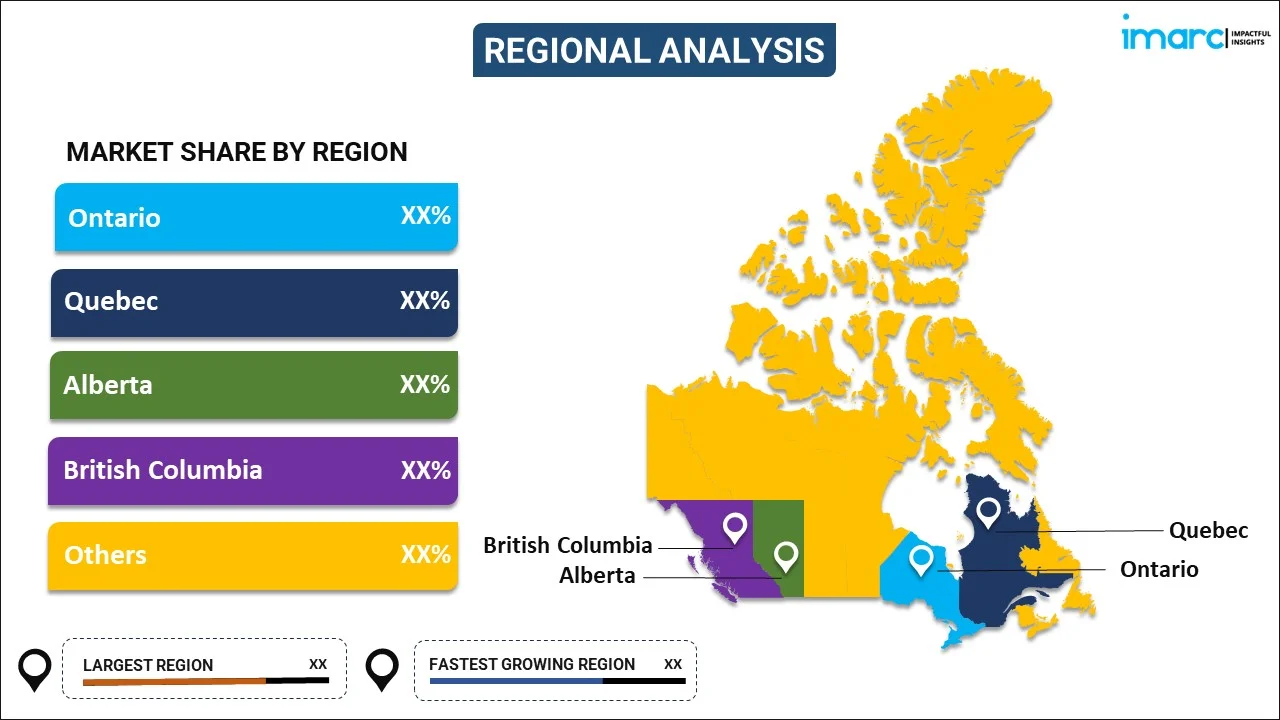
Canada IoT Device Management Market Report by Component (Solution, Services), Deployment Mode (Public Cloud, Private Cloud, Hybrid Cloud), Organization Size (Small and Medium-sized Enterprises, Large Enterprises), End User (Retail, Healthcare, Transportation and Logistics, Manufacturing, and Others), and Region 2025-2033
Canada IoT Device Management Market Overview:
The Canada IoT device management market size is projected to exhibit a growth rate (CAGR) of 12.83% during 2025-2033. The market is driven by the growing reliance on internet for communication and effective operation of IoT devices, along with the increasing demand for pay-as-you-go cloud services as it can be more affordable than maintaining on-premises infrastructure.
|
Report Attribute
|
Key Statistics
|
|---|---|
|
Base Year
|
2024 |
|
Forecast Years
|
2025-2033 |
|
Historical Years
|
2019-2024
|
| Market Growth Rate (2025-2033) | 12.83% |
Canada IoT Device Management Market Trends:
Increasing Reliance on Internet
According to an article published in 2024 on the website of the Statisque Canada, around 94% Canadians went online for personal use in 2022. Improvements in the infrastructure allow for robust and ubiquitous connectivity as more individuals get access to the internet. IoT devices, which depend on continuous internet access for communication and effective operation, cannot function without this pervasive connectivity. The need for consumer IoT devices, such as wearables, connected health devices, and smart home appliances, security systems, and thermostats, is increasing as the number of internet users is rising. Robust IoT device management solutions are necessary to successfully control these devices. Businesses and industries are utilizing IoT solutions more frequently to boost productivity, efficiency, and innovation as internet usage is rising. This covers applications in smart manufacturing, logistics, retail, and healthcare, all of which depend on thorough device management to operate at peak efficiency.
An increase in internet users leads to a rise in the amount of data created by IoT devices. For this data to be handled, verified, and used for insights and decision-making, efficient device management solutions are essential. The potential attack surface for cyber threats is growing as IoT devices proliferate and the number of users is increasing. IoT device management systems are essential for keeping an eye on, safeguarding, and updating devices to prevent hacks and vulnerabilities. An increasing number of internet users anticipate interactions with their gadgets that are dependable, easy to use, and seamless. IoT device management makes ensuring that gadgets are compatible, updated frequently, and operating at their best, which increases user happiness and adoption rates.
Growing Adoption of Cloud Computing by Companies
An article published in 2024 on the website of the Made in CA shows that 92% of Canadian companies use some form of cloud computing. Scalable resources that are easily adjustable to accommodate the growing number of IoT devices are provided via cloud computing. This adaptability is crucial for effectively overseeing extensive IoT implementations, enabling enterprises to grow their IoT networks without concern for infrastructure constraints. Pay-as-you-go cloud services can be more affordable than maintaining on-premises infrastructure because they often follow this paradigm. The need for cloud-based IoT device management platforms is being driven by this cost-efficiency, which makes it easier for businesses to adopt and manage IoT solutions.
IoT devices may be accessed remotely thanks to cloud computing, enabling real-time monitoring, upgrades, and troubleshooting from any location. This improves operational efficiency and reaction times and is especially useful for managing distributed IoT networks across various locations. The cloud offers enormous storage capacity and sophisticated analytics tools, which are necessary for managing the wide volumes of data produced by IoT devices. Utilizing these cloud capabilities, effective device management solutions gather, store, and analyze data to improve device performance and provide insightful information for decision-making.
Canada IoT Device Management Market News:
- December 2023: AWS launched second infrastructure region in Canada to provide customers with more options to run workloads with even greater resilience and availability.
- November 2023: KPMG in Canada and Microsoft Canada announced the launch of the Operational Risk Skills Development Center, a co-developed initiative, to offer free hands-on training to help businesses and governments build cybersecurity protection, navigate the opportunities and challenges of generative AI.
Canada IoT Device Management Market Segmentation:
IMARC Group provides an analysis of the key trends in each segment of the market, along with forecasts at the country level for 2025-2033. Our report has categorized the market based on component, deployment mode, organization size, and end user.
Component Insights:

- Solution
- Real-time Streaming Analytics
- Security Solutions
- Data Management
- Remote Monitoring
- Network Bandwidth
- Services
- Professional Services
- Managed Services
The report has provided a detailed breakup and analysis of the market based on the component. This includes solution (real-time streaming analytics, security solutions, data management, remote monitoring, and network bandwidth) and services (professional services and managed services).
Deployment Mode Insights:
- Public Cloud
- Private Cloud
- Hybrid Cloud
A detailed breakup and analysis of the market based on the deployment mode have also been provided in the report. This includes public cloud, private cloud, and hybrid cloud.
Organization Size Insights:
- Small and Medium-sized Enterprises
- Large Enterprises
The report has provided a detailed breakup and analysis of the market based on the organization size. This includes small and medium-sized enterprises and large enterprises.
End User Insights:
- Retail
- Healthcare
- Transportation and Logistics
- Manufacturing
- Others
A detailed breakup and analysis of the market based on the end user have also been provided in the report. This includes retail, healthcare, transportation and logistics, manufacturing, and others.
Regional Insights:

- Ontario
- Quebec
- Alberta
- British Columbia
- Others
The report has also provided a comprehensive analysis of all the major regional markets, which include Ontario, Quebec, Alberta, British Columbia, and Others.
Competitive Landscape:
The market research report has also provided a comprehensive analysis of the competitive landscape. Competitive analysis such as market structure, key player positioning, top winning strategies, competitive dashboard, and company evaluation quadrant has been covered in the report. Also, detailed profiles of all major companies have been provided.
Canada IoT Device Management Market Report Coverage:
| Report Features | Details |
|---|---|
| Base Year of the Analysis | 2024 |
| Historical Period | 2019-2024 |
| Forecast Period | 2025-2033 |
| Units | Million USD |
| Scope of the Report | Exploration of Historical Trends and Market Outlook, Industry Catalysts and Challenges, Segment-Wise Historical and Future Market Assessment:
|
| Components Covered |
|
| Deployment Modes Covered | Public Cloud, Private Cloud, Hybrid Cloud |
| Organization Sizes Covered | Small and Medium-sized Enterprises, Large Enterprises |
| End Users Covered | Retail, Healthcare, Transportation and Logistics, Manufacturing, Others |
| Regions Covered | Ontario, Quebec, Alberta, British Columbia, Others |
| Customization Scope | 10% Free Customization |
| Post-Sale Analyst Support | 10-12 Weeks |
| Delivery Format | PDF and Excel through Email (We can also provide the editable version of the report in PPT/Word format on special request) |
Key Questions Answered in This Report:
- How has the Canada IoT device management market performed so far and how will it perform in the coming years?
- What has been the impact of COVID-19 on the Canada IoT device management market?
- What is the breakup of the Canada IoT device management market on the basis of component?
- What is the breakup of the Canada IoT device management market on the basis of deployment mode?
- What is the breakup of the Canada IoT device management market on the basis of organization size?
- What is the breakup of the Canada IoT device management market on the basis of end user?
- What are the various stages in the value chain of the Canada IoT device management market?
- What are the key driving factors and challenges in the Canada IoT device management?
- What is the structure of the Canada IoT device management market and who are the key players?
- What is the degree of competition in the Canada IoT device management market?
Key Benefits for Stakeholders:
- IMARC’s industry report offers a comprehensive quantitative analysis of various market segments, historical and current market trends, market forecasts, and dynamics of the Canada IoT device management market from 2019-2033.
- The research report provides the latest information on the market drivers, challenges, and opportunities in the Canada IoT device management market.
- Porter's five forces analysis assist stakeholders in assessing the impact of new entrants, competitive rivalry, supplier power, buyer power, and the threat of substitution. It helps stakeholders to analyze the level of competition within the Canada IoT device management industry and its attractiveness.
- Competitive landscape allows stakeholders to understand their competitive environment and provides an insight into the current positions of key players in the market.
Need more help?
- Speak to our experienced analysts for insights on the current market scenarios.
- Include additional segments and countries to customize the report as per your requirement.
- Gain an unparalleled competitive advantage in your domain by understanding how to utilize the report and positively impacting your operations and revenue.
- For further assistance, please connect with our analysts.

 Inquire Before Buying
Inquire Before Buying
 Speak to an Analyst
Speak to an Analyst
 Request Brochure
Request Brochure
 Request Customization
Request Customization



.webp)




.webp)












